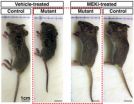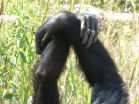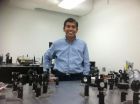(Press-News.org) ANN ARBOR, Mich.—Rising sea levels, melting glaciers, more intense rainstorms and more frequent heat waves are among the planetary woes that may come to mind when climate change is mentioned. Now, two University of Michigan researchers say an increased risk of avian influenza transmission in wild birds can be added to the list.
Population ecologists Pejman Rohani and Victoria Brown used a mathematical model to explore the consequences of altered interactions between an important species of migratory shorebird and horseshoe crabs at Delaware Bay as a result of climate change.
They found that climate change could upset the carefully choreographed interactions between ruddy turnstone shorebirds and the horseshoe crabs that provide the bulk of their food during the birds' annual stopover at Delaware Bay, a major estuary of the Delaware River bordered by New Jersey to the north and Delaware to the south.
Climate change-caused disruptions to the well-timed interplay between the birds and crabs could lead to an increase in the avian influenza infection rate among ruddy turnstones and resident ducks of Delaware Bay, the researchers found. Because Delaware Bay is a crossroads for many bird species traveling between continents, an increase in the avian infection rate there could conceivably help spread novel subtypes of the influenza virus among North American wild bird populations, according to Rohani and Brown.
Their findings were published online Aug. 29 in the journal Biology Letters.
"We're not suggesting that our findings necessarily indicate an increased risk to human health," said Rohani, a professor of ecology and evolutionary biology, a professor of complex systems and a professor of epidemiology at the School of Public Health.
"But every single pandemic influenza virus that has been studied has included gene segments from avian influenza viruses. So from that perspective, understanding avian influenza transmission in its natural reservoir is, in itself, very important."
Avian influenza refers to infection with bird flu Type A viruses. Those viruses occur naturally among wild aquatic birds worldwide and can infect domestic poultry and other bird and animal species.
Avian flu viruses do not normally infect humans. However, sporadic human infections with avian flu viruses have occurred. Since 2003, for example, more than 600 cases—including more than 300 deaths—of human infection with highly pathogenic avian influenza A H5N1 have been reported worldwide, according to the World Health Organization.
Delaware Bay, which hosts many resident bird species as well as the hundreds of thousands of migratory birds that gather to feed on horseshoe crab eggs, is known as a hot spot for avian influenza virus. Infection levels in ruddy turnstones, which stop at Delaware Bay each May during their northbound migration to breeding grounds in the Arctic after wintering in South America, have been found to be exceptionally high.
The birds time their arrival at Delaware Bay to coincide with the availability of the horseshoe crab eggs. Brown and Rohani wondered what would happen to influenza levels in Delaware Bay birds if climate change altered the timing of the ruddy turnstone's migratory flight to Delaware Bay or affected the timing of horseshoe crab spawning.
Their mathematical model looked at virus infection rates in ruddy turnstones and two species of duck—mallards, which winter at the bay, and American black ducks, which live there year-round.
The researchers found that if ruddy turnstones reached Delaware Bay either several weeks earlier or later than their current May arrival date, influenza infection rates in the species increased significantly, driving up the infection rates—also called prevalence levels—in the resident ducks as well.
"If the ruddy turnstones arrive either earlier or later than they do now, then their arrival coincides with higher viral prevalence in the resident ducks," said Brown, a postdoctoral research fellow in the Department of Ecology and Evolutionary Biology and the Center for the Study of Complex Systems. "And because these birds are interacting with a greater number of infected resident ducks, prevalence levels in ruddy turnstones are boosted.
"There's a feedback mechanism at work as well. Higher prevalence levels in the ruddy turnstones may, in turn, impact the prevalence levels in the resident ducks, driving them even higher."
If the timing of the horseshoe crab spawning season at Delaware Bay changed significantly due to climate change, ruddy turnstone populations would drop significantly due to a loss of food, and the influenza infection rate would decrease sharply as well, the researchers found.
Delaware Bay was declared a site of hemispheric importance by the Western Hemisphere Shorebird Reserve Network in 1986. Sites of hemispheric importance act as staging, nesting or breeding grounds for at least 500,000 shorebirds annually, or at least 30 percent of the biogeographic population of any species.
###
Pejman Rohani:www.lsa.umich.edu/eeb/directory/faculty/rohani
Climate change could increase levels of avian influenza in wild birds
2012-08-29
ELSE PRESS RELEASES FROM THIS DATE:
ESC analysis reveals arrhythmia treatment gaps between Eastern and Western Europe
2012-08-29
The analysis was conducted using five editions of the EHRA White Book, which is produced by the European Heart Rhythm Association (EHRA), a registered branch of the European Society of Cardiology (ESC).
The EHRA White Book reports on the current status of arrhythmia treatments in the 54 ESC member countries and has been published every year since 2008. Data is primarily provided by the national cardiology societies and working groups of cardiac pacing and electrophysiology of each ESC country. Prospective data is collected on catheter ablation and on implantation of cardiovascular ...
TAVI restricted to very old or very sick patients
2012-08-29
The registry is part of the European Society of Cardiology (ESC) EURObservational Research Programme (EORP) of surveys and registries.
Today's presentation reveals current usage of the most modern TAVI valves and catheters in Europe, and compares indications, techniques and outcomes between different countries. "TAVI is a new technology which has been introduced in Europe but many question marks remain on which patients are most suitable," said Professor Di Mario. "We set up this registry because it was important to have a clear picture of clinical practice in Europe. ...
Added benefit of fampridine is not proven
2012-08-29
Fampridine (trade name Fampyra®) has been approved in Germany since July 2011 for adult patients suffering from a higher grade walking disability (grades 4 to 7 on the EDSS disability status scale), as a result of multiple sclerosis (MS). The German Institute for Quality and Efficiency in Health Care (IQWiG) has assessed the added benefit of the drug pursuant to the Act on the Reform of the Market for Medicinal Products (AMNOG). According to the findings, there is no proof of added benefit, as the manufacturer's dossier contains no evaluable study data for the comparison ...
Could a cancer drug potentially prevent learning disabilities in some kids?
2012-08-29
ANN ARBOR, Mich. — A drug originally developed to stop cancerous tumors may hold the potential to prevent abnormal brain cell growth and learning disabilities in some children, if they can be diagnosed early enough, a new animal study suggests.
The surprising finding sets the stage for more research on how anti-tumor medication might be used to protect the developing brains of young children with the genetic disease neurofibromatosis 1 -- and other diseases affecting the same cellular signaling pathway.
The findings, made in mice, are reported in the journal Cell ...
Belimumab for lupus erythematosus: Added benefit not proven
2012-08-29
Belimumab (trade name Benlysta ®) has been approved since July 2011 as an add-on therapy for adult patients with the autoimmune disease systemic lupus erythematosus (SLE). This monoclonal antibody is only considered as treatment when the disease is still active in spite of standard therapy. The German Institute for Quality and Efficiency in Health Care (IQWiG) has now examined the added benefit of this drug pursuant to the Act on the Reform of the Market for Medicinal Products (AMNOG).
According to the findings, there is no proof that belimumab provides added benefit ...
Mount Sinai researchers solve mystery surrounding the death of two sisters nearly 50 years ago
2012-08-29
Researchers at Mount Sinai School of Medicine have identified the genetic cause of a rare and fatal bone disease by studying frozen skin cells that were taken from a child with the condition almost fifty years ago. Their study, which details how the MT1-MMP gene leads to the disease known as Winchester syndrome, appears in the August 23, 2012 online edition of The American Journal of Human Genetics.
In 1969, Patricia Winchester, MD, a pediatric radiologist in New York City, was asked to diagnose two young sisters who were losing bone in their hands and feet, developing ...
Biomass characterization technology research highlighted in Industrial Biotechnology journal
2012-08-29
New Rochelle, NY, August 29, 2012--Biomass recalcitrance--the problem of how to break down complex plant-based cellulosic feedstock into sugars that can be fermented to produce sustainable biofuels and other renewable biobased products—can be overcome through improved methods of biomass characterization. IB IN-DEPTH, a collection of articles from leading research laboratories describing advanced tools and techniques for analyzing the chemistry, structure, and interaction of biomass components, is published in Industrial Biotechnology, a peer-reviewed journal from Mary Ann ...
Chimpanzees create social traditions
2012-08-29
A research collaboration between the Gonzaga University and the Max Planck Institute shows that the way in which chimpanzees groom each other depends on the community to which they belong. Specifically, it is the unique handclasp grooming behaviour that reveals this local difference.
The specific behaviour that the researchers focused on was the 'grooming handclasp', a behaviour where two chimpanzees clasp onto each other's arms, raise those arms up in the air, and groom each other with their free arm. This behaviour has only been observed in some chimpanzee populations. ...
Breakthrough in nanotechnology
2012-08-29
A University of Central Florida assistant professor has developed a new material using nanotechnology, which could help keep pilots and sensitive equipment safe from destructive lasers.
UCF Assistant Professor Jayan Thomas, in collaboration with Carnegie Mellon University Associate Professor Rongchao Jin chronicle their work in the July issue of the journal Nano Letters. (http://dx.doi.org/10.1021/nl301988v)
Thomas is working with gold nanoparticles and studying their properties when they are shrunk into a small size regime called nanoclusters. Nanoparticles are already ...
Soaking up the Sun
2012-08-29
Solar panels, like those commonly perched atop house roofs or in sun-drenched fields, quietly harvesting the sun's radiant energy, are one of the standard-bearers of the green energy movement. But could they be better – more efficient, durable and affordable? That's what engineers from Drexel University and The University of Pennsylvania are trying to find out, with the aid of a little nanotechnology and a lot of mathematical modeling.
A three-year grant from the National Science Foundation has set the team on a track to explore ways to make new photoelectric cells more ...


